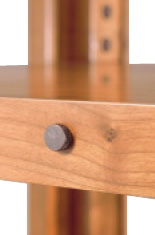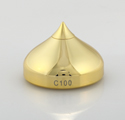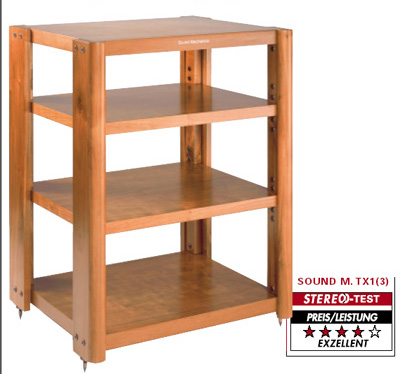Stereo
Magazine, Germany 3/2005
Seeing
the Whole Picture
Sound
Mechanics focuses on the suppression and elimination
of disturbing resonances through their racks, feet
and unusual bases.
By
Tom Frantzen
Oak
is considered to be unbending. It resists attack through
sheer mass and energy absorption, whereas, bamboo
bends flexibly and diverts destructive wind energy.
Both may be compared with the underlying principles
of Asian martial arts, such as Karate, which employs
hard blocking and Aikido, which is gentle and flexible.
These two principles function comparably in this new
HiFi furniture by applying two construction principles:
damping and attenuation by mass, and fastest possible,
loss-free dispersion of energy. Sound Mechanics (in
operation for over four decades in Hong Kong) would
like to bring both philosophies under one hat and
to optimise the challenges of sound improvement. Oscillations
should be kept within measure so that they are neither
too weakly nor too strongly dampened and are dispersed
in both vertical and horizontal directions.
Each
construction detail is to the highest test standard.
Wood is the key material in providing natural timbre.
It is not allowed to be too thick under any circumstances.
Greatest attention has been applied to form and geometry,
as in the bevelled edge of the platforms. The influence
may have been derived from esoteric elements of Asian
philosophy, such as Feng Shui, but the process is
strictly rooted in physics.
 That
becomes clear also with the C100-Brass-Supporting-Feet
(3-piece set) for loudspeakers, which, naturally and
by no means coincidently, optimally absorb acoustic
radiation by virtue of their aspheric form. Although
Harmonix had already developed a similar octagonal
plate with an indent to accept a spike, the C101 (3-piece
set) offers comparable quality at a more attractive
price. That
becomes clear also with the C100-Brass-Supporting-Feet
(3-piece set) for loudspeakers, which, naturally and
by no means coincidently, optimally absorb acoustic
radiation by virtue of their aspheric form. Although
Harmonix had already developed a similar octagonal
plate with an indent to accept a spike, the C101 (3-piece
set) offers comparable quality at a more attractive
price.
The
slightly mysterious wood hemispheres with fillings
in many built in non-spherical chambers are offered
in different levels of quality. Unwanted oscillations
and vibrations are absorbed. Practically each form
and filling is patented - the German patent specification
is stated as appropriate for "acoustic absorption
devices" - and this principle is especially important
to the chief technical designer, Frederik Kwoh.
It
is also of no surprise that the C8W-Type walnut wood
hemispheres filled with six different materials is
the designer's favourite, because for only 75 euro
it produces almost perfect sound when arranged under
a CD player. Leaving aside the impact of the test
product's value, it is an outstanding achievement
in its own right.
Dynamics
are increased as the sound field is cleansed, while
at the same time voices are brought into focus. The
musical flow increases, and the whole gains more authenticity
by being naturally more flawless. We are already eager
to learn the opinions of the ten readers to whom these
supporting feet were sent for testing.
The
type C8B (beech, 3 piece set) with eight materials,
and the MC 88  (Blackwood,
3 piece set) filled with ten materials, one of which
is tungsten, increase resolution and gently lighten
the sound. While the small cones are less sensitive
and practically always function - with the larger
ones you must be careful of the resulting tonal balance.
When they work, they are however clearly better and,
particularly for more expensive components, would
be first choice. The fundamental view of Sound Mechanics
is to use the earth as their means to dissipate unwanted
oscillation (mechanical) and electrical charge/disturbance. (Blackwood,
3 piece set) filled with ten materials, one of which
is tungsten, increase resolution and gently lighten
the sound. While the small cones are less sensitive
and practically always function - with the larger
ones you must be careful of the resulting tonal balance.
When they work, they are however clearly better and,
particularly for more expensive components, would
be first choice. The fundamental view of Sound Mechanics
is to use the earth as their means to dissipate unwanted
oscillation (mechanical) and electrical charge/disturbance.
Looking
at oscillation as "mechanical noise" and its analogy
to the electrical connection is remarkable and merits
special attention. Additionally, Sound Mechanics'
racks are magnetically earthed. Which means both the
TX Rack shelves and the separate equipment platform,
the PX 2000, are naturally shielded. The two-piece,
absorption and transmission coating technology is
meant to translate electrical and electromagnetic
fields as well as high frequencies into a form of
energy that is harmless to the musical event.
The
interior structure of the platforms is complex. Sound
earthing is built into massive wood strips (Multi
Laminor), which are aligned for oscillation dispersion.
Also, a "q-Layer" is used, an organic mass for the
reduction of the q-factor of the respective platform.
 Sound
Mechanics simply rejects metal for the building of
racks. The resonance behaviour of straight hollow
metal tubes is considered to be completely unsuitable
to the benefit of the music lover. Sound
Mechanics simply rejects metal for the building of
racks. The resonance behaviour of straight hollow
metal tubes is considered to be completely unsuitable
to the benefit of the music lover.
Instead,
they improve the suspension of the platforms by using
solid hardwood frameworks in the rack for better "mechanical
grounding". The sum of all the detailed measures aims
to provide an electrically calmer, more harmonious
starting point with greater resolution of details
including an increase in fine dynamics.
Taking all into consideration, the racks of the TX
series and the tuning measures in both the form of
cones or platform rank among the best accessories
we have seen and heard in the last few years regardless
of price.
These
products from Hong Kong are even more interesting
when one considers the moderate pricing structure
- particularly, since not only the technical underpinnings,
but also quality of manufacture are completely convincing.
Clarity
of sound is the focus of what Sound Mechanics offers.
Their products, without question, genuinely enrich
the accessory market. Employing predominantly mechanical
measures at comparatively modest cost, Sound Mechanics
products lead to clearly audible improvements. An
absolute must try!
|